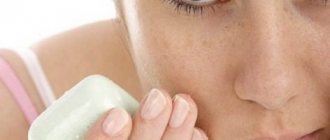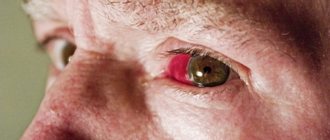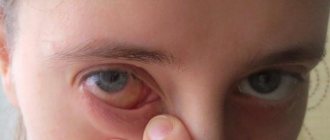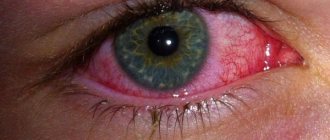Causes
There are many reasons for the development of a vesicle on the mucous membrane of the eye. The most common factors of formation are viral diseases, but there are other diseases in which this symptom manifests itself:
- Adenovirus. This is a common viral infection that is characterized by a red throat and fever. If the patient does not have treatment or the function of his immune system is impaired, a complication occurs. One of them is the formation of a bubble on the mucous membrane of the eyes.
- Herpes. The pathogen circulates in the blood and nerve tissues of almost all people. If the patient is exposed to a negative environmental factor or the immune function is reduced, rashes may occur on various areas of the skin or blisters may appear on the mucous membranes.
- Cyst. A bubble forms on the mucous membrane area and fills with liquid. This is a minor condition that can be easily treated by an ophthalmologist. But if an infection gets inside, pus forms, increasing the risk of infection of the internal tissues of the eyeball.
- Allergy. During seasonal exacerbations, reactions often occur in the eye area. This includes increased lacrimation and redness of the conjunctiva. Bubbles rarely form.
- Inflammatory and infectious diseases of the eyes. Bubbles are a consequence of a complication of an untreated disease that appears in the area of the mucous membrane, cornea, and conjunctiva.
- Papilloma. Most often, a rash due to the disease forms on the eyelids. But in especially severe cases it can spread to the mucous membrane of the eyes.
The doctor needs to identify the exact cause of the disease in order to prevent the risk of relapse after treatment.
Homeopathic treatment for blisters on eyelids
In some cases, homeopathy is the last island of hope for patients with various diseases, including blisters on the eyelids. The products are not addictive and can be used for a long time.
Important! The basic rule: the homeopathic doctor must individually select the drug and its dosage for you.
| A drug | Symptoms |
| Calcarea carbonica (Calcarea carbonica) | Conjunctivitis, blisters on the mucous membrane of the eye. |
| Pulsatilla (Pulsatilla) | Inflammation of the eyes during a cold, blisters on the mucous membrane, burning and pain in the eyeball. |
| Rhus toxicodendron (Rus toxicodendron) | Conjunctivitis, blisters and ulcers on the mucous membrane of the eye, photophobia, severe headache. |
| Sulfur (Sulfur) | Frequent swelling, pain in the eyes, blisters in the eyes. |
| Allium cepa | Allergic itching of the eyes, blisters on the eyelids. |
| Arsenicum Album (Arsenicum Album) | Allergic manifestations in the eyes. |
Why did a bubble appear on the eyeball?
Adults, as a rule, do not pay much attention to minor rashes or redness on their bodies. But when it comes to children, every attentive parent will take their child to the doctor. This is explained by the fact that children’s bodies are very delicate and vulnerable to various types of infections. The following causes of rash in this area in children can be identified:
- There are cases when a viral disease is accompanied by non-standard symptoms of acute respiratory infections, and blisters on the eyelids;
- Mostly the appearance of blisters in children is caused by molluscum contagiosum;
- other viral infections.
Bubbles on the eyelids
Bubbles on the eyelids under the eyelashes: causes of appearance
Most often, blisters are not an independent disease, but only a symptom that indicates an illness. There are many reasons why bubbles appear on the eyes. It all depends on their size, as well as additional symptoms that occur when infected with a certain disease.
Causes of transparent blisters on the eyelids:
- Papilloma. Often appears in the form of a single bubble. Most often, this is a layer of several bubbles that appear along the eyelash line. They can be both above and below, and do not cause pain. They rarely disappear on their own. Triggered by the penetration of the human papillomavirus into the body or its exacerbation. The fact is that with a decrease in immunity, the tear changes its composition; there are fewer immunoglobulins in it, which are able to fight viruses. This may cause bubbles to form.
- Barley. Along with the blister on the eyelid, swelling, pain, and redness are observed. Triggered by staphylococcus or streptococcus. That's why it is treated with antibiotics.
- Moll cyst. It is a blister, painless, with viscous, thick contents. This is not pus, but fat that appears on the eyelid as a result of improper functioning of the sebaceous glands. Most often, such neoplasms resolve on their own, but do not completely go away. When the immune system is weakened, such a wen appears again, but already causes additional symptoms, such as pain, blurred vision, and the sensation of a foreign body in the eyes.
- Also, blisters on the eyelids often appear as a result of allergic reactions . They are observed on pollen, poplar fluff or cosmetics. Therefore, if you purchased some new cosmetics and noticed the appearance of bubbles on your eyelids, stop using them. Most likely, it was this cosmetic product that caused the appearance of bubbles on the eyelids.
Bubbles on the eyelids
Symptoms
The symptoms of the patient's condition depend on the cause that caused the disease. The most common signs are:
Non-surgical eye treatment in 1 month.
- the formation of a vesicle without any clinical symptoms, for example, with a cyst;
- pain, itching, burning in the eye area;
- sensation of a foreign body under the eyelids;
- deterioration of visual acuity;
- accompanying rash on the eyelids;
- blurred vision;
- increased pain when exposed to bright light;
- increased production of tear fluid;
- swelling, inflammation of the skin surfaces and eye tissues;
- discomfort when turning the eyes.
If the liquid inside is clear, this phenomenon is most often associated with a common cyst or virus. If the secretion becomes cloudy and yellow, the doctor will suspect suppuration. If the cause is herpes, and the blister bursts, the contents will infect surrounding healthy tissue. Subsequently, the liquid from the bubble will spread throughout the eyes and eyelids.
Associated symptoms
General symptoms depend on the specific diagnosis, as well as the severity of the disease. Most often, a person is concerned about the following additional signs:
- sensation of a foreign body in the eye;
- deterioration of visual acuity;
- increased lacrimation;
- pain, itching, burning in the eye area;
- discomfort when rotating the eyeballs;
- feeling of a veil, blurred vision;
- increased pain in bright light.
In some cases, this condition is practically not accompanied by additional symptoms other than the formation of a vesicle. This happens, for example, with a cyst.
Is it possible to use traditional methods to get rid of unpleasant symptoms?
There are several most common folk methods that can be used for such diseases. Their effect is that they are able to reduce discomfort several times, relieve burning and itching, and reduce swelling. Ways to get rid of unpleasant sensations can be listed as follows:
- To reduce itching, lotions with solutions of novocaine and menthol are applied to the eyelids;
- The eyes are washed three times a day with a solution of boric acid;
- The use of tea compresses is the most well-known method, characterized by good effectiveness. Tea is considered an excellent antiseptic. To prepare a compress, pour a couple of teaspoons of dry tea leaves into a glass of boiling water. When the resulting liquid has cooled, cotton pads should be soaked in it and placed on the surface of the closed eyes for a few minutes;
- Exactly the same as in the previous version, brew chamomile. Before use, filter the infusion;
- An aqueous one percent solution of propolis is dripped into the affected eye, two drops at a time. This procedure must be carried out eight times a day;
- Compresses, contrasting in temperature - applying a piece of clean cloth soaked in cold water to the eyes, then doing the same, but taking hot water;
- The juice of plants, such as aloe or plantain, is diluted with water in an amount of 1:1. Use the solution obtained in this way for compresses.
It is forbidden to use ointment medications with a cauterizing effect, do not overcool and stay in a draft for a long time. Those areas where there is a bubble on the white of the eye must be protected from dirt and dust.
Regardless of the reason for the appearance of bubbles, scratching and rubbing them is not allowed. If their integrity is compromised, the naturally created protection against infection is also compromised. There are many reasons why a transparent bubble may appear on the white of the eye; the diagnosis and choice of treatment should be made by a specialist.
source
How to treat blisters on the eyes?
We do not recommend treating blisters on the eyelids and eyes on your own; consult an ophthalmologist. It may be necessary to consult an endocrinologist, therapist, and otolaryngologist. It all depends on the reasons for the appearance of bubbles. Depending on the disease, the treatment method is chosen.
Review of treatment methods and drugs:
- If the blister is caused by a herpes virus, Acyclovir is most often prescribed. This is an ointment that will lubricate the mucous membrane. They may also prescribe antiviral drops such as Poludan or antibiotics to prevent a bacterial infection.
- A Moll cyst goes away on its own within 10 days. If this does not happen, and it has increased in size, the doctor makes a puncture to extract the contents of the vesicle.
- Formations that arise as a result of exposure to the papilloma virus do not go away on their own; they must be removed using a laser or freezing. Now in many clinics there are devices with which such tumors are removed. The manipulation is practically painless and the burn site heals very quickly, without causing any pain or side effects.
- If the blisters are caused by an allergy due to the use of a new cosmetic product, it is necessary to undergo a course of treatment with antihistamines . Diazolin, Loratadine or Cetrin are prescribed. Artificial tear drops may also be prescribed in order to restore lavage to the eye and prevent the mucous membrane from drying out.
Barley
Diagnostics
To diagnose a patient’s condition, an integrated approach and many techniques are used:
- Anamnesis collection. This is data obtained from the words of the patient or his close relatives. Based on them, the doctor can guess the cause of the disease.
- General examination of the superficial tissues of the organs of vision. The doctor diagnoses the condition of the eyelids and mucous membranes. Swelling and inflammation may occur. A bubble on the mucous membrane immediately catches the eye.
- Eye swab. Based on this, you can determine the viral or infectious nature of the disease. If an increased number of bacteria is detected, a culture will be performed. It will be used to detect the exact pathogen and the antibiotic that can affect it.
- Fundus examination. To do this, a solution is instilled into the patient's eyes, which temporarily disrupts the accommodation of the pupil. The doctor can determine or rule out the spread of infection to the internal structure of the eyes. The condition of the lens, cameras, retina, and microcirculation vessels is assessed.
Based on diagnostic tests, a reliable diagnosis can be made. Treatment begins immediately to prevent the development of complications.
Causes
There are many reasons for such a problem. The most common of them include the following.
Conjunctivitis
More precisely, adenoviral conjunctivitis, which occurs as a complication after pharyngitis. Often, bubbles with transparent contents appear on the mucous membrane of the eyelids. They are not always small; sometimes they are quite large. If these are consequences of conjunctivitis, then their treatment will be difficult.
The adenoviral form of conjunctivitis develops in the body due to the following reasons:
- Poor hygiene, for example, using someone else's towel, introducing the virus into the eyes through the touch of dirty hands. Visiting public swimming pools, saunas, etc.
- Close contact with an infected person - the conjunctivitis virus is quickly and easily transmitted.
- Prolonged stay outside in adverse weather conditions.
- Mechanical damage to the eye.
- Using expired or low-quality mascara.
Treatment
Treatment is carried out comprehensively depending on the cause that caused the disease:
- antiviral drugs that act on the detected pathogen (for example, for herpes, Acyclovir is prescribed in the form of tablets, drops, ointments);
- an antibacterial agent that has an effect on the pathogen that causes the disease;
- nonsteroidal anti-inflammatory drugs that eliminate inflammation in the eye area;
- drugs that stimulate the immune system;
- surgical intervention, which is most often performed under local anesthesia (used for cysts).
The doctor may also prescribe symptomatic treatment in the form of painkillers or drugs that reduce body temperature.
Treatment of blistering rashes
Therapy depends on the diagnosis that caused the rash on the lower eyelid:
- For herpes, the patient is prescribed local antiviral drugs; in some cases, treatment is supplemented by taking oral tablets with an antiviral component. To increase immunity, the patient needs to take a course of immunomodulators.
- For allergies, be sure to use local products with an antihistamine component. If the manifestations of allergies are too strong, then the patient is also advised to take oral antihistamines. It is very important here to identify the allergen and try to protect yourself from encountering it. If this is not possible (for example, the allergen is pollen), then the patient will have to take antiallergic drugs for so long until it is possible to eliminate the allergen from the reach zone. This may take several months.
- A Moll cyst usually resolves on its own, without outside help, within 5-10 years after its appearance. If the formation prevents the patient from leading an active life, or there is a possibility of injury, then it is better to remove the contents of the cyst in a specialist’s office through a small puncture.
- Therapy for ophthalmoherpes for the most part consists of treating a cold, which is the root cause. To reduce discomfort in the eye and speed up the spontaneous resorption of blisters, use local drops and ointments with an anti-inflammatory component.
- Formations that appear as a result of the activation of the human papillomavirus cannot be eliminated at home. They can only be removed surgically (cutting) or laser exposure. The procedures are performed under local anesthesia.
- The best advice for treating a burn is to try to disturb it as little as possible. If there is a possibility of injury to this area, as a result of which the bubble may burst, then a small breathable bandage is applied to it, which will prevent the entry of pathogens from the external environment in case of an accidental puncture.
Methods for eliminating pathology
It is possible to remove a watery formation on the whites of the eye only after a comprehensive diagnosis and clarification of the cause of its formation. In mild cases, it is possible to get rid of the bubble on the eyeball through medications. When the disorder is caused by an allergic reaction, the tumor goes away on its own after taking antihistamines. To eliminate the bubble, the medications listed in the table are often used:
In particularly advanced cases, surgical intervention is performed.
In advanced cases, when the bubble has grown to a large size and significantly affects visual function, surgical intervention is performed. The tumor is eliminated radically using a scalpel. This treatment method is often prescribed in case of cyst formation. During manipulation, the wall of the cystic neoplasm is excised so that the bubble does not form again in the future. The patient does not experience discomfort or pain during surgery, since the procedure is performed under local or general anesthesia. The rehabilitation period is short and easy. A few hours after excision of the vesicle in the area of the eyeball, the patient is allowed to go home if there are no complications.
The most effective and less painful way to remove a bubble on the mucous membrane of the eye is cauterization with a laser beam.
Prevention
To prevent the development of blisters in the eye area, it is recommended to adhere to the following rules:
- timely examination by an ophthalmologist at least once a year for the timely detection of minor abnormalities or serious diseases;
- treatment of all systemic viral and infectious diseases in a timely manner to prevent the development of complications;
- hardening, which is used in the form of visiting the pool, walking barefoot at home, drinking cold water;
- maintaining eye hygiene; if discharge appears, it is necessary to wash it with an antiseptic, for example, Furacilin.
What are the reasons for the appearance of bubbles on the organs of vision?
Problems with the eyes, expressed in the appearance of formations on their surface, can be caused by a variety of reasons, including:
- A person spends a long time outdoors, exposing his eyes to the rays of the sun;
- Respectable age. In older people, defense mechanisms weaken and processes occurring in the body slow down. The metabolism and absorption of nutrients deteriorates, which provokes an increased susceptibility to disease;
- Features of the profession when people are forced to experience the harmful influence of negative environments for a long time. The risk is considered increased for women and men who spend a lot of time in workshops, in contact with toxic fumes or small particles in the air that can cause mechanical injury;
- Hereditary factor. Such diseases are very difficult to treat; if surgically removed, their recurrence is possible;
- Living in a specific climate, where the constant air temperature is characterized as high, sandstorms often occur.
Diseases that can cause blisters to appear on the eyes
Adenoviral conjunctivitis
When the mucous membrane of the eyes becomes inflamed during pharyngitis, adenoviral conjunctivitis can occur. It is often accompanied by a significant increase in temperature. One of the manifestations of this kind of disease is the follicular appearance, in which small bubbles with transparent contents grow on the mucous membrane of the eyes.
Conjunctival cysts
Transparent, translucent formations that appear on the eyeballs or on the mucous membrane are conjunctival cysts. They can be either acquired or congenital. Often such formations occur after eye injury, as well as due to various inflammatory diseases. If they are small in size, cysts may not cause any particular inconvenience. Symptoms may appear subtle - for example, a feeling of sand in the eyes or excessive flow of tears.
When formed cysts grow in the eyes, pain and a feeling of fullness may appear. Vision may become less sharp. This disease must be treated surgically.
Pinguecula
The formations that form on the eye can be pale yellow or transparent in color. They are based on the apple of the eye itself in the conjunctival area. Their appearance occurs due to excess proteins and fats in the human body. In medical language, such a growth is called a pinguecula.
The occurrence of pinguecula does not harm health and does not impair the quality of vision. However, such a disorder cannot be ignored. If there are epithelial growths on the surface of the eye, it is worth thinking about the fact that this person is beginning to have big problems with the metabolism. Pinguecula is a sign that fatty foods and proteins are absorbed very poorly.
Growths on the surface of the eye may appear when a section of the epithelium degenerates. The cells change their structure, and a compaction is formed from them. The formation, which is benign, is localized on the ocular cornea or conjunctiva. How this or that pinguecula appeared can be judged by its appearance.
Ophthalmoherpes
In this disease, the pathogen becomes active when immunity declines. Signs of ophthalmoherpes are blisters that may appear on the cornea or on the skin of the eyelids. They are filled with a transparent secret. If a blister bursts, it can infect healthy tissue with its contents. In this case, the disease is aggravated - photophobia, lacrimation and hyperemia of the eyeballs may appear. If the disease develops to severe forms, blepharospasm appears, characterized by convulsive closure of the eyelids.
Why do blisters appear on the eyelids?
Low-quality cosmetics, poor hygiene, improper care of lenses, burns, infectious and allergic factors can cause bubbles in the eyes. May be affected: the lower or upper eyelid, the skin above and below the eyes, the membranes of the eye.
Herpetic infection
The herpes virus is present in almost 100% of people. With good immunity, the virus is in an inactive phase, without causing clinical symptoms. The herpes virus is activated when immunity decreases due to colds, exacerbations of chronic diseases, and immunodeficiency.
Small bubbles with transparent contents on the mucous membrane, eyelids, between the eyelashes are a typical manifestation of ophthalmoherpes. In the area of the blisters, a person experiences a burning sensation and itching. After a few days, the blisters burst, a crust forms, after which healing occurs.
The addition of a secondary infection leads to inflammation of the eyes. Herpetic infection can affect all membranes of the eye, causing conjunctivitis, keratitis, uveitis, and retinitis. Ophthalmoherpes, left unattended, leads to irreversible deterioration of vision up to blindness.
To view the comments of a professional on the topic of ophthalmoherpes.
Adenoviral conjunctivitis
The classic triad of symptoms of adenovirus infection: conjunctivitis, pharyngitis, fever. The follicular form of adenoviral conjunctivitis is manifested by the formation of blisters on the inside of the eyelid. A person feels a foreign body in the eye, the eye turns red and swells.
Allergic reaction
A rash of transparent blisters on the eyelids after contact with an allergen is a sign of an allergy. Allergens can be food products, cosmetics, industrial substances, plants, and medications.
The allergy is manifested by the appearance of transparent blisters, the eyelids turn red, swell, and itch. A severe allergic reaction is accompanied by skin rashes, difficulty breathing due to swelling of the throat, and decreased blood pressure.
Conjunctival cyst
A round, watery formation on the conjunctiva is called a conjunctival cyst. A transparent bubble forms on the mucous membrane of the eye, which gradually increases, creating a feeling of discomfort. Conjunctival cysts can be congenital or acquired (after injury, inflammation of the eye).
Moll cyst
When the sebaceous gland is blocked, a small bubble forms, usually on the lower eyelid, less often on the upper. This formation is called a Moll cyst. It is provoked by herpes viruses, human papillomavirus infection, allergies, and low-quality cosmetics.
A Moll cyst manifests itself as redness and burning. With significant sizes, a person experiences discomfort and a feeling of compression. The cyst is not dangerous to health, resolves on its own, and is prone to re-formation. In case of relapse, it is removed surgically.
Papilloma
A wart on the eyelid (papilloma) is caused by the human papillomavirus (HPV). There are about 100 types of HPV, which differ in oncogenic risk. That is, some types are capable of causing cancer with a high probability, some with an average or low probability.
Papilloma can form on the upper or lower eyelids, as well as other parts of the body. May vary in shape, size, color. Eyelid papillomas that grow quickly, bleed, suppurate, have an irregular shape, and are unevenly colored require diagnosis by an oncologist.
Burn
Thermal, radiation or chemical exposure leads to the formation of blisters on the eyelids. This is possible if safety precautions are not followed when working in dangerous laboratories or at home.
Types of burns:
- Thermal. Caused by flames and hot liquids.
- Chemical. Caused by the ingress of alkalis, concentrated acids, and aggressive chemicals.
- Ray. Damage to the eye from ionizing radiation, ultraviolet, infrared rays.
The burn is accompanied by severe pain, lacrimation, and redness. The eyelid closes and swells. With deep damage, charring of the skin is observed. If the mucous membrane and deeper structures of the eye are affected, then in addition the person notices clouding and scarring on the whites of the eyes, deterioration of visual functions, blurred vision, and flickering flashes.
What is the pathology associated with?
If small balls appear in the eye, this may indicate an inflammatory reaction in the conjunctiva. A common source of vesicles is adenovirus-type conjunctivitis, which is diagnosed with prolonged pharyngitis. Against the background of the disease, not only does a blister appear on the sclera of the eye, but also the body temperature rises. Other pathological factors can also influence the disorder:
- Herpes virus infection. Almost every patient has such microorganisms, but they do not appear until a certain point. A weak immune system, colds and other reasons lead to the activation of the virus, which is why a yellow or white bubble appears on the white of the eye.
- Cystic formation. The most common cause of the formation of a bubble on the eyeball. As a rule, the neoplasm is not accompanied by any other symptoms and may not bother a person for a long time until it grows to a large size, disrupting visual function.
- Allergic reaction. Often, against the background of the patient's allergies, small bubbles formed in the area of the eyeball and eyelids are disturbing. More often women face this problem.
- Inflammatory and infectious diseases.
- Infection with papillomavirus. Neoplasms of this type often form on the eyelids; less often, papilloma is diagnosed on the cornea or eyeball. The disorder can be eliminated with the help of immunostimulating and antibacterial drugs.
Return to contents
Bubbles on the eyelids under the eyelashes, eye treatment, prevention
Bubbles on the eyelids, right under the eyelashes at the roots, appear spontaneously and disappear just as imperceptibly.
They are not a separate disease; rather, they are a symptom that indicates the presence of some process in the body.
What are these bubbles?
A bubble located on the edge of the eyelashes of the upper or lower eyelid may not even be immediately noticed. Most often it is noticed when there is itching and a sensation of a foreign body in the eye.
By itself, it is a small ball filled with transparent contents - serous fluid. Sometimes it can be seen inside the eyelid directly on the mucous membrane. As a rule, the presence of blisters is not accompanied by any additional symptoms, but in some cases the following manifestations are present:
- Redness of the area where the blister is located.
- Local increase in temperature around the bubble localization site.
- Itching is always present, sometimes severe.
- Feeling of sand in the eyes, pain.
How are they formed
The process of formation of a bubble with liquid on the eyelid may not be noticed at all. There is nothing even remotely reminiscent of the formation of, for example, barley. One day, when you feel itching in the eyelid area and look closely in the mirror, you discover that there is some kind of transparent formation there.
If you postpone taking action for some time, you may not even find it in its place. And only over time does a person understand that such bubbles appear with a certain frequency.
This makes you think about the reasons for their occurrence. This is not a serious illness, so there is no need to panic right away. But it never hurts to find out the reasons.
To do this, you need to see a doctor.
Causes
There are many reasons for such a problem. The most common of them include the following.
Conjunctivitis
More precisely, adenoviral conjunctivitis, which occurs as a complication after pharyngitis. Often, bubbles with transparent contents appear on the mucous membrane of the eyelids. They are not always small; sometimes they are quite large. If these are consequences of conjunctivitis, then their treatment will be difficult.
The adenoviral form of conjunctivitis develops in the body due to the following reasons:
- Poor hygiene, for example, using someone else's towel, introducing the virus into the eyes through the touch of dirty hands. Visiting public swimming pools, saunas, etc.
- Close contact with an infected person - the conjunctivitis virus is quickly and easily transmitted.
- Prolonged stay outside in adverse weather conditions.
- Mechanical damage to the eye.
- Using expired or low-quality mascara.
Conjunctivitis has different forms, but only its follicular form gives complications in the form of transparent blisters. In this case, there will be several bubbles and sometimes they even merge all together, then open together. After this, an open wound remains, into which pathogenic microorganisms enter.
Conjunctivitis is accompanied by the following symptoms:
- Increased body temperature.
- Purulent contents in the eyes. During wakefulness during the day it is almost unnoticeable, but it causes the eyelids to stick together after a night's sleep.
- Redness of the eyeball, a pronounced bright capillary pattern on it.
- Sensation of sand in the eyes, accompanied by pain.
- Increased tear production.
- Itching in the eyes, sometimes unbearable.
- Redness of the conjunctiva of the eye, swelling of the eyelids.
The disease lasts from 5 days to several weeks. Its chronic form is characterized by attacks that accompany a person throughout his life, with a certain frequency.
Allergy
If a person has a tendency to allergic manifestations, then it is likely that transparent blisters on the eyelid are a consequence of contact with allergens. The symptoms are still the same - redness and swelling of the eyelids, itching and burning, severe tearing, redness of the eyeball. The patient has a persistent desire to rub his eyes, to remove sand from them that is not there.
However, with allergies there are a number of other signs - a rash on the skin of the body, a decrease in blood pressure, difficulty breathing if there is swelling of the throat.
It is important to remember here that it is necessary to exclude contact with the allergen, otherwise all measures taken will be ineffective. Factors that cause such a reaction are as follows:
- Decorative cosmetics and skin care products are of low quality or expired.
- Use of household chemicals.
- Some types of food are allergic to citrus fruits and chocolate.
- Treatment with antibacterial drugs for a long time or with products containing extracts of medicinal herbs.
- Having pets or contact with other people's pets. Allergy to wool is one of the most common.
- Wearing contact lenses incorrectly means their expiration date or improper care.
Almost 20% of the entire world population has allergies, so, first of all, this factor must be eliminated.
Ophthalmoherpes
The herpes virus is present in the body of every person. Another thing is that up to a certain point it behaves quite peacefully and does not manifest itself in any way if a person has a good strong immune system.
If factors favorable to it arise, it appears on the surface of the skin, for example, in the form of bubbles on the lips (this manifestation is more familiar to everyone). However, the appearance of the same transparent blisters on the eyelids can also be herpes.
The symptoms of ophthalmic herpes are no different from those described in previous cases:
- Lacrimation is severe, with redness of the eyeball.
- Sunphobia, the eye reacts sharply to ultraviolet radiation - there is a desire to close the eyes.
- Sensation of sand getting into the eyes, pain.
- Convulsive contractions of the eyelids - if herpes has an advanced or untreated form.
- Upon examination, bubbles were revealed directly on the corneal layer of the eye. After they burst, small ulcerations remain.
- Increased body temperature, muscle pain, chills.
With herpes, there is a high probability of a secondary infection, which leads to inflammation of the eye. With herpetic lesions, as a rule, the blisters are not isolated; all membranes of the eye are affected.
This causes conjunctivitis, keratitis, retinitis and other pathologies to rapidly progress. If ophthalmoherpes is not treated promptly, irreversible consequences develop, including a sharp decrease in vision and complete blindness.
The complexity of the disease depends on the state of the patient’s immune system and his age. The blisters themselves most often occur as a complication of colds. With properly selected therapy, recovery occurs within 7-12 days.
Papillomas
Papilloma is a wart; it is, of course, difficult to confuse it with a transparent vesicle. But at some point in its development it may have some similarities with him. HPV (human papillomavirus) has more than 100 varieties, their peculiarity is the presence of oncogenic risk. Some types of papilloma are more likely to cause cancer, while others are less likely.
The neoplasm is localized on the upper or lower eyelid, and also occurs on any part of the body. The shape, size and color of papillomas are all purely individual. You need to be careful if the papilloma increases in size, bleeds, fills with purulent contents, or changes color. In these cases, it is necessary to show it to an oncologist.
Papilloma will never disappear spontaneously; it is of a substandard nature. Papillomas occur during periods of decreased immunity. When this happens, the tear changes its composition, there are fewer immunoglobulins in it, the function of which is to protect against viruses. Then bubbles appear, and then papillomas. Possible reasons for the development of papillomas include:
- Infection enters the body through microscopic wounds and cracks.
- Prolonged contact with a person susceptible to this disease, especially the use of the same personal hygiene items, cosmetics, and cutlery.
Transparent
Transparent bubbles indicate the development of all of the above diseases. As already mentioned, these are single or multiple bubbles merging with each other.
They remain on the eyelids for some time, and then burst with an outpouring of transparent (or cloudy, depending on the pathology) contents. After this, a small wound with a crust remains on the surface of the skin.
White
The appearance of white blisters on the lower or upper eyelid may indicate the development of stye. The reason for this may be an infection in the hair follicle or gland located near the root of the eyelash.
First there is itching and some swelling of the tissues, pain. After 2-3 days, a capsule of pus becomes visible on the surface of the skin. As a rule, it opens on its own, but sometimes this requires the help of a doctor. The causes of barley can be very different: decreased immunity, anemia, diabetes mellitus, demodicosis, blepharitis or conjunctivitis.
Eye treatment
Once the diagnosis is made, treatment is prescribed.
Medication
This type of treatment involves the following areas:
- Prescribing antiviral drugs. These include eye drops "Ophthalmoferon", "Aktipol", ointments "Acyclovir", "Zovirax" - they are placed behind the eyelid, tablets Acyclovir and Valacyclovir.
- The use of antihistamines is necessary to relieve the corresponding manifestations. This group of drugs includes eye drops “Cromohexal”, “Allergodil”, tablets Suprastin and Cetrin, treatment will be ineffective if the allergen is not excluded.
- Surgical intervention is necessary when there is a papilloma or conjunctival cyst. This could be laser surgery, cryodestruction or surgery.
- Treatment with antiseptics is carried out in all cases.
- If necessary, antibiotics, antiviral and hormonal drugs are prescribed.
Traditional methods
- Washing your eyes with chamomile decoction gives good results. To do this, it must be brewed in boiling water in a ratio of 1:20.
- Honey lotions are useful only if you are not allergic to it. Honey is diluted with boiled water in a ratio of 1:2 and used for lotions.
- Aloe juice in the form of lotions. You can squeeze a little juice onto a cotton pad, or you can apply a leaf with the inner side with pre-cut spines. It’s good if you can leave the compress on all night.
- Rinsing with a decoction of oatmeal eliminates itching.
This is done twice a day - morning and evening.
Preventive measures
For the purpose of prevention, the following measures are required:
- Strengthen the hygiene of the eyelid and eyelash area. Every day in the evening, you need to carefully remove all the dirt that has collected on your eyelashes and eyelids during the day, and completely remove your makeup.
- Eliminate the habit of touching your eyes with unwashed hands.
- Maintain proper level of immunity.
- Lead an active lifestyle, regularly spend time in the fresh air.
- Temper the body.
- Eat a balanced and healthy diet, set a diet high in fresh vegetables and fruits.
Reviews
- “Such bubbles are not uncommon for me; they appear in spring and autumn. I already know that when immunity decreases, they appear. That’s why I try to strengthen it.” Anna, 29 years old.
- “I thought my eye was itching, I looked closer and there was a small bubble. I didn’t do anything, I washed it with chamomile, it disappeared on its own the next day. Then this happened again and again. Now I know that this is the result of anemia - I have it almost constantly.” Veronica, 34 years old.
Watch a video about eyelid papillomas:
Select it and press Ctrl+Enter to let us know.
Source: https://glaza.online/zabol/vek/puzyrki-na-vekah-pod-resnitsami.html
What should you do if you notice blisters on your eye?
If strange formations appear on the surface of the eyes, you should act as follows:
- First of all, visit an ophthalmologist. The earlier the diagnosis is made, the better the treatment provided;
- Strict adherence to hygiene standards is required. When washing, you should treat your visual organs as carefully as possible. To wipe your face, the towel must be individual;
- To avoid damage, do not rub your eyes too hard; you cannot remove the formations yourself. This may increase the development of the disease;
- The use of low-quality cosmetics should be avoided;
- If the presence of allergies is noted, it is necessary to exclude the effect of allergens on the body. It will be necessary to work out the food system and, if necessary, eliminate contact with pets.










